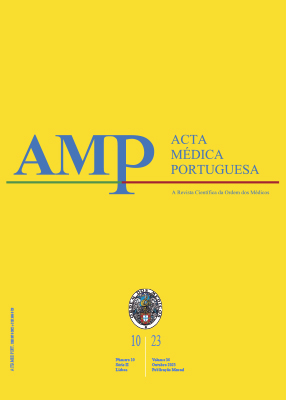Surgical Management of Bilateral Limbal Stem Cell Deficiency
DOI:
https://doi.org/10.20344/amp.18960Keywords:
Corneal Diseases/surgery, Epithelium, Corneal, Eye Burns/complications, Limbus Corneae, Ophthalmologic Surgical Procedures, Prosthesis Implantation, Stem CellsAbstract
At the age of 43 years-old, a man was left with bilateral limbal stem cell deficiency after an ocular alkaline burn with lime, which resulted in corneal opacification. After multiple unsuccessful surgical attempts to restore vision, including penetrating keratoplasties and Boston keratoprosthesis, visual acuity was counting fingers in the left eye. At 73 years of age, the patient underwent another surgery in his left eye. Cauterization of neovessels and removal of the vascular pannus were followed by partial excision of Tenon’s capsule. Penetrating keratoplasty was followed by an intrastromal injection of anti-VEGF (vascular endothelial growth factor), and the ocular surface was covered with amniotic membrane. Postoperatively, the graft was clear with no signs of inflammation; vision improved to 20/50 and remained stable throughout the following two years. Herein we describe some adjunctive procedures that might have delayed failure and rejection of the corneal graft. This case demonstrates the difficulties in treating bilateral limbal stem cell deficiency in a tertiary eye care center with no capacity to perform stem cell therapy.
Downloads
References
Deng SX, Borderie V, Chan CC, Dana R, Figueiredo FC, Gomes JA, et al. Global consensus on definition, classification, diagnosis, and staging of limbalstem cell deficiency. Cornea. 2019;38:364-75. DOI: https://doi.org/10.1097/ICO.0000000000001820
Kate A, Basu S. A review of the diagnosis and treatment of limbal stem cell deficiency. Front Med. 2022;9:836009. DOI: https://doi.org/10.3389/fmed.2022.836009
Iyer G, Srinivasan B, Agarwal S, Agarwal M, Matai H. Surgical management of limbal stem cell deficiency. Asia Pac J Ophthalmol. 2020;9:512-23. DOI: https://doi.org/10.1097/APO.0000000000000326
Ghareeb AE, Lako M, Figueiredo FC. Recent advances in stem cell therapy for limbal stem cell deficiency: a narrative review. Ophthalmol Ther. 2020;9:809-31. DOI: https://doi.org/10.1007/s40123-020-00305-2
Elhusseiny AM, Soleimani M, Eleiwa TK, ElSheikh RH, Frank CR, Naderan M, et al. Current and emerging therapies for limbal stem cell deficiency. Stem Cells Transl Med. 2022;11:259-68. DOI: https://doi.org/10.1093/stcltm/szab028
Deng SX, Kruse F, Gomes JA, Chan CC, Daya S, Dana R, et al. Global consensus on the management of limbal stem cell deficiency. Cornea. 2020;39:1291-302. DOI: https://doi.org/10.1097/ICO.0000000000002358
Selver OB, Gurdal M, Yagci A, Egrilmez S, Palamar M, Cavusoglu T, et al. Multi-parametric evaluation of autologous cultivated Limbal epithelial cell transplantation outcomes of Limbal stem cell deficiency due to chemical burn. BMC Ophthalmol. 2020;20:325. DOI: https://doi.org/10.1186/s12886-020-01588-6
Figueiredo FC, Glanville JM, Arber M, Carr E, Rydevik G, Hog J, et al. A systematic review of cellular therapies for the treatment of limbal stem cell deficiency affecting one or both eyes. Ocul Surf. 2021;20:48-61. DOI: https://doi.org/10.1016/j.jtos.2020.12.008
Aravena C, Bozkurt TK, Yu F, Aldave AJ. Long-term outcomes of the Boston type I keratoprosthesis in the management of corneal limbal stem cell deficiency. Cornea. 2016;35:1156-64. DOI: https://doi.org/10.1097/ICO.0000000000000933
Lin X, Wen J, Liu R, Gao W, Qu B, Yu M. Nintedanib inhibits TGF-β-induced myofibroblast transdifferentiation in human tenon’s fibroblasts. Mol Vis. 2018;24:789-800.
Xi X, McMillan DH, Lehmann GM, Sime PJ, Libby RT, Huxlin KR, et al. Ocular fibroblast diversity: implications for inflammation and ocular wound healing. Investig Ophthalmol Vis Sci. 2011;52:4859-65. DOI: https://doi.org/10.1167/iovs.10-7066
Ghiasian L, Samavat B, Hadi Y, Arbab M, Abolfathzadeh N. Recurrent pterygium: a review. J Curr Ophthalmol. 2022;33:367-78. DOI: https://doi.org/10.4103/joco.joco_153_20
Yang HK, Lee YJ, Hyon JY, Kim KG, Han SB. Efficacy of bevacizumab injection after pterygium excision and limbal conjunctival autograft with limbal fixation suture. Graefes Arch Clin Exp Ophthalmol. 2020;258:1451-7. DOI: https://doi.org/10.1007/s00417-020-04704-w
Giannaccare G, Pellegrini M, Bovone C, Spena R, Senni C, Scorcia V, et al. Anti-VEGF treatment in corneal diseases. Curr Drug Targets. 2020;21:1159-80. DOI: https://doi.org/10.2174/1389450121666200319111710
Le Q, Deng SX. The application of human amniotic membrane in the surgical management of limbal stem cell deficiency. Ocul Surf. 2019;17:221-9. DOI: https://doi.org/10.1016/j.jtos.2019.01.003
Downloads
Published
How to Cite
Issue
Section
License
Copyright (c) 2023 Acta Médica Portuguesa

This work is licensed under a Creative Commons Attribution-NonCommercial 4.0 International License.
All the articles published in the AMP are open access and comply with the requirements of funding agencies or academic institutions. The AMP is governed by the terms of the Creative Commons ‘Attribution – Non-Commercial Use - (CC-BY-NC)’ license, regarding the use by third parties.
It is the author’s responsibility to obtain approval for the reproduction of figures, tables, etc. from other publications.
Upon acceptance of an article for publication, the authors will be asked to complete the ICMJE “Copyright Liability and Copyright Sharing Statement “(http://www.actamedicaportuguesa.com/info/AMP-NormasPublicacao.pdf) and the “Declaration of Potential Conflicts of Interest” (http:// www.icmje.org/conflicts-of-interest). An e-mail will be sent to the corresponding author to acknowledge receipt of the manuscript.
After publication, the authors are authorised to make their articles available in repositories of their institutions of origin, as long as they always mention where they were published and according to the Creative Commons license.









